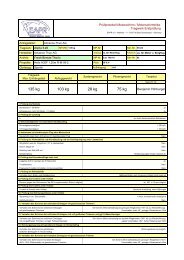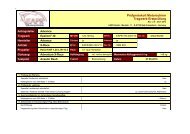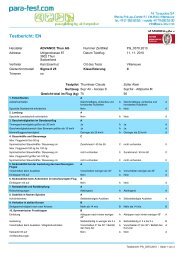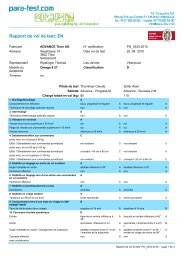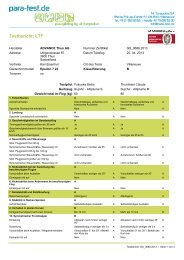Getting started (PDF) - Advance
Getting started (PDF) - Advance
Getting started (PDF) - Advance
You also want an ePaper? Increase the reach of your titles
YUMPU automatically turns print PDFs into web optimized ePapers that Google loves.
<strong>Getting</strong> <strong>started</strong><br />
english
Welcome to ADVANCE<br />
Many thanks for choosing ADVANCE. We are<br />
one of the world’s leading paraglider manufacturers<br />
and are based in Switzerland. Since<br />
1988 we have consistently followed our own<br />
paths and concepts, both in development<br />
and production. We hope that your PI will<br />
bring you many rewarding hours in the air.<br />
ribs, thus saving more weight. The certified<br />
weight range allows for a very wide range of<br />
wing loadings and the PI is one of the lightest<br />
serial gliders, designed for Hike & Fly pilots<br />
right up to the Extreme Alpinist variety. Soaring<br />
and thermal flying are very much possible<br />
in good conditions.<br />
The PI is a completely new development.<br />
Made of light materials it has a clever line<br />
configuration which does away with diagonal
<strong>Getting</strong> <strong>started</strong><br />
This guide gives you a brief look at using<br />
your PI, but it does not replace the official<br />
manual, where you will find detailed instructions<br />
about setting up, flying characteristics,<br />
manoeuvring, upkeep and service.<br />
The manual can be downloaded from<br />
www.advance.ch/pi
You as pilot<br />
The PI certified weight range covers very different<br />
wing loadings and this puts a correspondingly<br />
varied range of demands on its<br />
55<br />
55<br />
pilots:<br />
in this weight range. The PI really does offer<br />
an alternative low-end intermediate to<br />
the mountain walker, hiker, traveller, or<br />
just a weight-sensitive pilot.<br />
50 60 65 70 75 80 85 90 95 100 105 110115<br />
115<br />
50 60 65 70 75 80 85 90 95 100 105 110<br />
Hike&Fly Pleasure Range: Here the PI is<br />
aimed at leisure Hike & Flyers who would<br />
like to spend some time thermaling after<br />
walking up an off road peak. Even allowing<br />
for the relatively small wing the PI climbs<br />
well and has a notable glide performance<br />
Mountain Intense Range: This is the upper<br />
weight range, where the PI is intended for<br />
mountain and high-altitude touring. In the<br />
Mountain Intense Range the small wing<br />
provides dynamic flying fun with agreeable<br />
agile handling – suitable for pilots who
50 55<br />
60 65 70 75 80 85 90 95 100 105 110 115<br />
have the experience to cope with the dynamic<br />
behaviour of a small wing. When<br />
flown in this weight range the PI is a wing<br />
for experienced pilots and frequent flyers.<br />
kg<br />
50<br />
55 60 65 70 75 80 85 90 95 100 105 110 115<br />
PI 19<br />
PI 23
Delivery and initial settings<br />
Every ADVANCE paraglider has to be flown<br />
by the dealer before delivery to check for<br />
correct basic settings. Any personal alteration<br />
you make to the paraglider will result in it losing<br />
its certification. The brake line lengths<br />
should not be altered. They are set at the<br />
factory so that, with brakes fully released,<br />
the trailing edge remains unbraked in accelerated<br />
flight.<br />
The PI delivery package contains:<br />
• PIPACK<br />
• Compressing inner bag<br />
• Repair kit<br />
• Mini windsock<br />
• Booklet ’<strong>Getting</strong> <strong>started</strong>’<br />
Risers with an accelerate system (speed system<br />
and trimmers) are available as an option.
Caution: If the original risers are<br />
changed for the optional risers the<br />
PI loses its certification!<br />
PIPACK – the tailor-made light packsack
Handling and manoeuvring<br />
The required level of piloting for the PI depends<br />
on the wing loading. Please note that<br />
at high wing loading the PI is a dynamic wing.<br />
Be aware of the sink rate during steep turn<br />
reversals and plan the end of your flight accordingly.<br />
It is not possible to make a B-stall with the PI<br />
because the A and B lines are connected.<br />
Big ears are not possible with the PI 19 for<br />
the same reason. The PI 23 has an extra<br />
base line which makes it possible to fold<br />
the ears.<br />
And again - collapses cannot be simulated<br />
because the A and B lines share the same<br />
riser.<br />
ADVANCE strongly advise against carrying<br />
out the following manoeuvres because of the<br />
high momentum effects involved:<br />
• One-sided stall (spin)<br />
• Fullstall
Descent aids<br />
The ADVANCE test team recommend the<br />
steep spiral as a quick and efficient way of<br />
getting down fast. On the PI 23 it is also<br />
possible to use big ears.<br />
Tip: Practise fast descents in calm<br />
air now and then, so that they do<br />
not become an emergency when<br />
required.<br />
Big ears<br />
Big ears are not possible with the PI 19 because<br />
the A and B lines are linked. This was<br />
done to reduce the total number of lines – for<br />
simplicity and weight-saving: the PI can lose<br />
height well enough by turning, wingovering<br />
and spiral diving. In any case, big ears would<br />
be difficult to do with such a small wing, and<br />
does not feel comfortable for the pilot.
Unlike the PI 19 the PI 23 has an additional<br />
A base line which makes big ears possible. To<br />
apply big ears pull both of these outer A lines<br />
(marked with a red sleeve) quickly down together.<br />
This will collapse the wingtips which<br />
can easily be held in the folded position. To<br />
reopen just let the lines go; the PI 23 wingtips<br />
will open by themselves due to the high<br />
internal wing pressure.<br />
Caution: Be careful not to encourage<br />
a stall while flying with big ears. Beware<br />
of applying brakes with big<br />
ears and avoid this method of descent<br />
with a wet glider.
Landing<br />
Always make a good circuit with a defined final<br />
approach. Keep sufficient speed, then<br />
apply increasing brake to level out the flightpath<br />
as the ground comes up, finally going<br />
through to full brake for a zero speed touchdown.<br />
When landing in zero wind be prepared<br />
to take two or three run-out steps.<br />
• Steep turn reversals cause large<br />
pendulum swings of the pilot;<br />
this should be avoided near the<br />
ground.<br />
• Braking gives you low speed and<br />
a high sink rate; you can also be<br />
sure that manoeuvrability will be<br />
greatly restricted.<br />
• Flying below minimum speed<br />
leads to stalling; this should unquestionably<br />
be avoided when<br />
top landing, and on final approach.
Flying with a wet paraglider<br />
There’s a risk of parachutal stall. Parachutal<br />
stall is often the result of a combination of<br />
factors. The water adds to the weight of the<br />
glider. The additional weight causes a higher<br />
angle of attack, putting the glider closer to<br />
the stall. Then again, water drops on the<br />
wing surface disturb the laminar airflow near<br />
the front of the wing, significantly reducing<br />
the maximum lift coefficient available.<br />
In order to guard against the risk of parachutal<br />
stall with a wet wing the glider should<br />
braked as little as possible and big ears<br />
should not be used under any circumstances.<br />
If, however, the PI does go into parachutal<br />
stall recovery can only be made by pushing<br />
on the A risers.
Info: With the optional risers fitted<br />
recovery from parachutal stall<br />
should be made by using the speed<br />
system (speedbar or trimmers).
Packing and care<br />
Handle with care!<br />
The PI is made as light as possible and designed<br />
for a specific function. Handle the PI<br />
lightweight materials sensitively. The PI will<br />
only supply long-lasting delight if it is looked<br />
after carefully. Think about what the ‘Handle<br />
with Care’ label means each time you see<br />
it, because the lifespan of this product depends<br />
to a great extent on your own care<br />
and attention.<br />
Pack up your PI rib to rib so that the leading<br />
edge plastic rods lie flat on each other, all at<br />
the same height. The PI will compress down<br />
to a small volume in the conical inner bag<br />
supplied, and will then fit perfectly in your<br />
PIPACK or EASINESS.<br />
Always pack or store your paraglider dry.
Warranty and Service<br />
Register your PI online within 10 days of purchase<br />
on www.advance.ch/garantie. The<br />
ADVANCE warranty is valid for 3 years to<br />
cover defects that are attributable to manufacturing<br />
faults. There are more details online.<br />
Your PI has to have a check every 24 months<br />
– or every 12 months or 100 flights if it is<br />
used a lot. You can find detailed information<br />
about the worldwide ADVANCE Service Network<br />
on www.advance.ch .<br />
You can find the up-to-date version of the<br />
detailed official manual, more advice about<br />
safety, and current information including answers<br />
to frequently asked questions (FAQs)<br />
on www.advance.ch.
Technical details<br />
ADVANCE PI 19 23<br />
Flat surface m 2 19.00 23.00<br />
Take off weight 2 kg 50 – 95 65 – 115<br />
Glider weight * kg 2.45 2.85<br />
Aspect ratio 4.5 4.5<br />
Trim speed 1 km/h 42 +/- 1 42 +/- 1<br />
Best glide 1 8.1 8.1<br />
Weight PIPACK kg 0.35 0.35<br />
Volume PIPACK lt 36 36<br />
Certification EN/LTF C 65 – 99 kg / EN/LTF B<br />
100 – 115 kg / EN/LTF C<br />
* The weight of each size can vary up to 100 g as a function of the fabric manufacture process.<br />
1 Values depend on wing loading (pilot/harnesses and glider) 2 Pilot, wing, equipment
A1 A2<br />
ADVANCE PI 19 Detail lineplan ADVANCE PI 23<br />
A3 A4<br />
A5<br />
A6<br />
A7<br />
A8<br />
2A1 2A2<br />
A9<br />
2A3<br />
A10 A10<br />
2A4<br />
A11<br />
A11<br />
B1 B2 B3 B4<br />
A12<br />
A12<br />
B5 B6<br />
B7<br />
A13<br />
A13<br />
B8<br />
B9<br />
2B1 2B2<br />
B10<br />
A14<br />
2B3 2B4<br />
B11 2A5<br />
B10<br />
A14<br />
B11 2A5<br />
2A6<br />
A15<br />
3AB1<br />
2A6<br />
A15<br />
3AB2<br />
B12<br />
B13<br />
B12 B13<br />
2B5<br />
B14<br />
B14<br />
C1 C2 C3 C4 C5 C6<br />
2B6<br />
3A3<br />
C7 C8<br />
B15 A16<br />
2B5<br />
B15 A16<br />
C9 C10 C11 3AB3<br />
C10<br />
2B6<br />
C11 C12<br />
C13<br />
2C1 2C2<br />
2C3<br />
C12 C14 B16<br />
C13<br />
St A<br />
C14 B16<br />
C15<br />
3B3<br />
C15 St A<br />
2C4<br />
St B<br />
St B<br />
2C5<br />
C16<br />
2C5<br />
C16<br />
2C6<br />
St C<br />
2C6<br />
St C<br />
D1 D2 D3 D4 D5 D6 D7 D8 D9 D10 D11 D12 D13 D14 D15<br />
D10 D11 D12 D13 D14 D15<br />
St D<br />
St D<br />
C St<br />
C St<br />
3D1 3D2<br />
2D5<br />
3D3 3D4<br />
2D6<br />
2D5 2D6<br />
3CD3<br />
9<br />
3CD3<br />
9<br />
3CD1<br />
3CD2<br />
7<br />
8<br />
7<br />
8<br />
6<br />
6<br />
5<br />
5<br />
3 4<br />
1 2<br />
F1 F2 F3 F4<br />
F4<br />
VR1<br />
VR2<br />
SL up<br />
SL low
advance thun ag<br />
uttigenstrasse 87<br />
ch 3600 thun<br />
www.advance.ch<br />
info@advance.ch<br />
fon +41 33 225 70 10<br />
fax +41 33 225 70 11



